Introduction to the Importance of E-commerce Website Design in the Digital Age
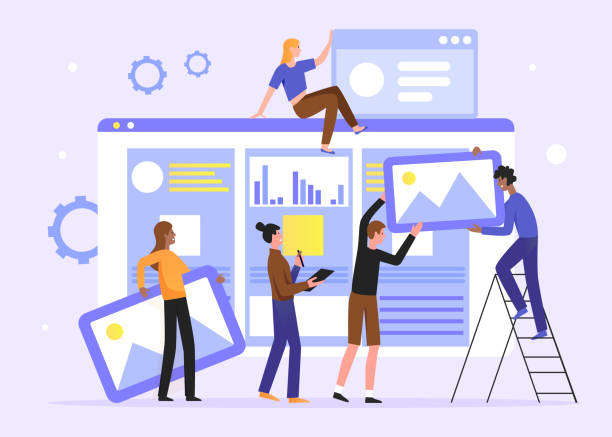
In today’s world, an online presence for any business, from the smallest startups to industrial giants, is no longer an option; it’s a vital necessity.
This need reaches its peak, especially in the realm of selling products and services.
E-commerce website design that is efficient and attractive is a gateway to an endless market that transcends geographical boundaries, allowing you to offer your products to customers from all over the world.
This digital transformation has changed people’s #lifestyle and transformed their #expectations for shopping.
Customers are no longer limited to physical stores but are looking for convenience, speed, and 24-hour access, which can only be achieved through a well-equipped #online_store.
The importance of an e-commerce website is not limited to increased accessibility.
Proper e-commerce website design means creating a seamless and enjoyable user experience that can increase customer loyalty and significantly improve the conversion rate.
Imagine your customers being able to browse for desired products, read their specifications, make comparisons, and finally complete their purchase with a few simple clicks, at any hour of the day or night, without leaving their homes.
This level of convenience is not only appealing to customers but also brings numerous benefits to businesses, including reduced operational costs, the ability to collect valuable data on customer behavior, and the capability to run targeted marketing campaigns.
In an era where competition is at its peak, having a powerful e-commerce website not only sets you apart from competitors but also lays the foundation for your business’s long-term growth and development.
From attractive product displays with high-quality images and comprehensive descriptions to secure payment processes and efficient support, every aspect of e-commerce website design must be carefully considered.
This process not only requires technical knowledge but also a deep understanding of customer psychology and market trends.
Therefore, investing in a professional design tailored to your business needs is a strategic decision that will yield a significant return on investment and prepare you for success in the digital world.
In the continuation of this article, we will discuss in detail various aspects of e-commerce website design, from choosing the right platform to optimizing for search engines and ensuring user data security.
Our goal is to provide a comprehensive and practical guide so that you can make the best decisions for launching or improving your online store with full awareness.
This is an exciting path that opens countless potentials for your business and leads it to a new level of success.
Is your e-commerce website ready to attract maximum customers and increase sales? Rasaweb transforms your online business with modern and efficient e-commerce website designs.
✅ Increased speed and improved SEO
✅ Excellent user experience on mobile and desktop⚡ Get a free consultation for e-commerce website design from Rasaweb!
Examining the Essential Pillars of a Successful E-commerce Website Design
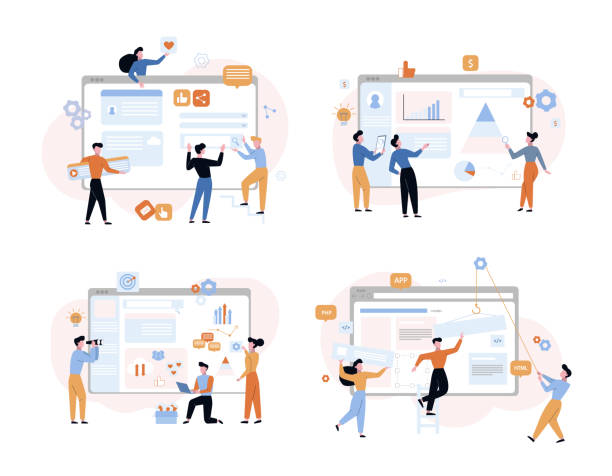
For an e-commerce website design to be truly successful, a set of key and essential pillars must be considered.
These pillars go beyond merely having an online platform for sales and include technical, visual, and interactive aspects.
The first and perhaps most important pillar is #simple_navigation and #user-friendly_design.
Users should be able to easily navigate your site, find their desired products, and complete the purchase process without any complications.
A disjointed and confusing design can quickly lead to user abandonment and lost customers.
Therefore, paying attention to User Experience (UX) is of paramount importance.
The second essential pillar is the quality of content and product display.
High-quality and professional photos of products, comprehensive and accurate descriptions, product introduction videos, and user reviews are all factors that build customer trust and help them in their purchasing decisions.
E-commerce website design must allow for optimal display of this content.
Small but vital details, such as product image zoom, display of different dimensions and colors, and the ability to compare products, can make a huge difference in conversion rates.
Providing clear and complete information gives the customer a sense of confidence that they are purchasing a product that meets their expectations.
The third pillar is site loading speed and its responsiveness (Responsive Design).
In today’s age, no user is willing to wait for e-commerce website pages to load.
Slow speed directly leads to high bounce rates and lost sales. Furthermore, given the widespread use of mobile phones for online shopping, the website design must be such that it displays correctly on all devices, including mobile and tablet, and provides a consistent user experience.
This means responsive design and optimization of images and site code.
Security and reliability are the fourth important pillars in e-commerce website design.
Customers must be confident that their personal and financial information is secure throughout the purchasing process.
The use of SSL certificates, secure payment gateways, and adherence to security standards are among the necessities in this area.
Lack of attention to security can lead to loss of customer trust and severe damage to your business’s reputation.
These aspects are not only technical but also serve as explanatory content and guidance for business owners.
Finally, attention must also be paid to SEO (Search Engine Optimization) and marketing aspects.
A successful e-commerce website design must be built on SEO principles from the outset to attract organic and targeted traffic.
Also, the ability to integrate with marketing tools such as email marketing, social networks, and data analysis systems (like Google Analytics) for performance tracking and continuous improvement is essential.
All these pillars are interconnected and must be considered simultaneously to achieve a powerful online store.
Common Platforms and Tools for Implementing E-commerce Website Design
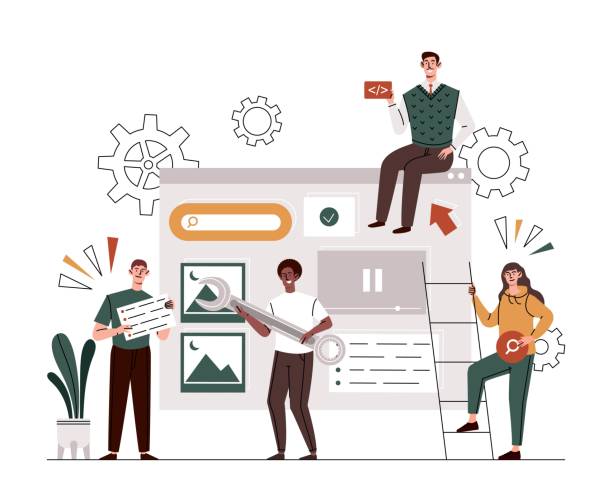
For implementing an e-commerce website design, various platforms and tools are available, each with its own features, advantages, and disadvantages.
Choosing the right platform is one of the most important decisions at the start of the project and should be made carefully based on your specific business needs, budget, and long-term goals.
Among the most popular of these platforms are #WooCommerce for WordPress, #Shopify, #Magento, and custom platforms.
Each of these options offers a different approach to e-commerce.
WooCommerce, as a powerful plugin for WordPress, is one of the most popular options for e-commerce website design.
This option is very suitable for small and medium businesses because it offers high control over site design and functionality, and its initial costs are relatively low.
However, it requires technical knowledge for maintenance and updates.
Shopify is a SaaS (Software as a Service) platform that manages all technical aspects of hosting and maintenance.
This option is ideal for those who want to launch an online store without getting involved with technical complexities.
Although it has monthly fees, its ease of use and comprehensive features make it an attractive option.
Magento (now renamed Adobe Commerce) is a very powerful and flexible platform suitable for large businesses and organizations with complex needs.
This platform offers very high customization capabilities but requires significant technical expertise for its implementation and management and can also incur high costs.
Custom platforms are another option, designed and developed by development teams for very specific and unique business needs.
This approach provides maximum flexibility but is the most expensive and time-consuming option.
The table below provides a comparison between some common platforms for e-commerce website design, which can help you choose the most suitable option.
This specialized and explanatory content helps you choose your platform with a clearer perspective.
| Feature | WooCommerce (WordPress) | Shopify | Magento |
|---|---|---|---|
| Required technical skill level | Medium to High | Low | Very High |
| Initial Cost | Low (hosting only) | Monthly (free trial) | High |
| Flexibility and Customization | High | Medium | Very High |
| Scalability | Medium to High | High | Very High |
| Technical Support | Strong user community | Provided by Shopify | Provided by Adobe and their partners |
Choosing the right platform directly affects the development speed, maintenance costs, and future capabilities of your online store.
Careful consideration of your business needs and consultation with e-commerce website design specialists can help you make the best decision.
Each platform has its unique features that must be carefully evaluated to ensure complete alignment with your business goals.
User Experience (UX) and User Interface (UI) in E-commerce Website Design
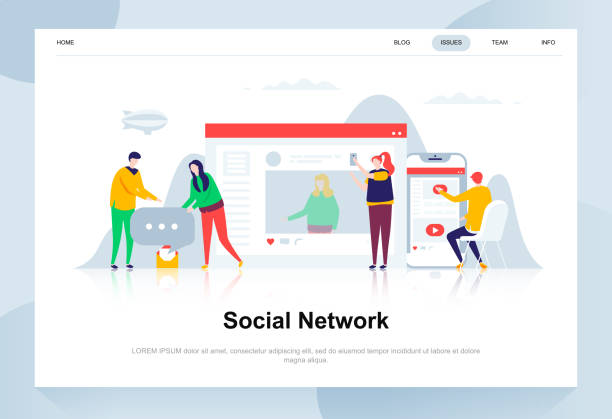
In the context of e-commerce website design, two key concepts that directly impact the success or failure of an online store are User Experience (UX) and User Interface (UI).
Although often confused, they play different roles and are both essential for creating an effective e-commerce website.
#UI refers to the visual #appearance and #feel of the site: colors, fonts, layout of elements, buttons, and forms.
The goal of UI is to create an attractive and coherent visual experience.
In contrast, UX refers to the user’s entire journey interacting with the site: how easily they can find their desired product, how smooth the purchasing process is, and whether they feel satisfied throughout this journey.
A good UX means the usability, efficiency, and enjoyable interaction of the user with the site. In e-commerce website design, focusing on UX means that customers can quickly and without confusion browse products, add them to their cart, and complete the payment process.
Crucial UX elements in an online store include intuitive navigation, high loading speed, responsive design for display on different devices, a simple and low-step payment process, and powerful and accurate product search.
Also, providing sufficient and useful information about each product, including detailed descriptions, high-quality images from different angles, introduction videos, and user reviews, significantly helps improve the user experience.
An excellent user experience not only helps increase sales but also encourages customers to return to your site and become loyal customers.
In the UI section, the importance of aesthetics and visual consistency should not be underestimated.
An appealing visual design can make the first positive impression on the user.
Choosing appropriate colors, fonts, and images, a well-organized layout, and clear buttons all contribute to increased visual appeal and ease of use.
Furthermore, a good UI should be consistent with your brand identity and evoke a sense of professionalism and trust.
The intelligent combination of UI and UX in e-commerce website design creates not only a beautiful website but also a powerful sales tool.
To ensure optimal UX and UI in the e-commerce website design process, conducting user research, A/B testing, and collecting customer feedback are crucial.
These analytical approaches help you identify the strengths and weaknesses of your design and implement necessary improvements.
Ignoring either of these aspects can lead to lost sales potential and an undesirable user experience.
Does your company’s website perform as it should for your brand? In today’s competitive world, your website is your most important online tool. Rasaweb, a specialist in professional corporate website design, helps you to:
✅ Gain credibility and customer trust
✅ Convert website visitors into customers
⚡ Get a free consultation!
Search Engine Optimization (SEO) to Increase E-commerce Website Traffic

One of the most important aspects of e-commerce website design that directly impacts its success is Search Engine Optimization or SEO.
Without SEO, even if you have the most beautiful and efficient online store, it will be difficult for potential customers to find it among millions of other sites.
The main goal of SEO is to #increase_visibility of your website in Google’s organic search results and other search engines.
This means attracting #targeted_traffic and free traffic, which leads to increased sales.
SEO steps in e-commerce website design must be considered from the very beginning.
This includes choosing appropriate keywords for products and categories, optimizing URL structures, correctly using Title Tags and Meta Descriptions for each page, and creating high-quality and unique content for product and blog pages.
Each product page should include relevant keywords, but not in a way that appears as “keyword stuffing”.
Valuable and informative content helps search engines identify your site as an authoritative source.
Technical SEO optimization is also crucial.
This includes ensuring high site loading speed (by compressing images, using caching, and optimizing code), responsive design, and a crawlable site structure for search engine bots.
Using a Sitemap and robots.txt file also helps search engines better understand your site’s structure and index your pages more effectively.
Ensuring that all your important pages are indexed is the first step in being seen online.
Off-Page SEO also plays an important role.
This means building high-quality backlinks from other reputable sites to your online store.
Backlinks show search engines that your site has authority and value.
Also, an active presence on social networks and encouraging users to share your content can indirectly help SEO.
Ultimately, SEO is an ongoing process, not a one-time task.
Search engine algorithms are constantly changing, and to maintain your ranking, you need to regularly analyze, update, and optimize your site.
Using tools like Google Search Console and Google Analytics to monitor SEO performance and identify improvement opportunities is essential.
By considering these points in your e-commerce website design, you can drive significant organic traffic to your store and increase your sales.
Security and Online Payment in E-commerce Store Design and Development

One of the most sensitive and vital aspects of e-commerce website design is the issue of security and ensuring the online payment process.
Customers will only make online purchases when they are completely confident in the security of their personal and financial information on your website.
Any security flaw can not only lead to the loss of sensitive user data but also quickly inflict irreparable damage to your business’s credibility and reputation.
#Data_security and #financial_transaction_security are the backbone of a successful online store.
The first step in ensuring security is the use of an SSL (Secure Sockets Layer) certificate.
SSL encrypts information exchanged between the user’s browser and your website server.
This prevents data interception by malicious actors and shows customers that your site is secure (by displaying a green padlock icon in the browser’s address bar and the https:// prefix).
The absence of SSL not only erodes user trust but can also negatively affect your site’s SEO ranking, as Google considers sites without SSL to be insecure.
Regarding the online payment process, using secure and reputable payment gateways is essential.
These gateways are responsible for securely processing financial transactions and ensure that user credit card information is transmitted encrypted and in accordance with international security standards (such as PCI DSS).
Correct integration with these gateways in e-commerce website design is crucial and must be performed by experienced developers.
Some e-commerce platforms, like Shopify, have their own internal payment gateways, while on platforms like WooCommerce, payment gateway plugins must be installed and configured.
Furthermore, e-commerce website design should include mechanisms to protect against common cyberattacks such as SQL Injection, XSS (Cross-Site Scripting), and DDoS.
Regular updates of the e-commerce platform, plugins, and themes, and the use of Web Application Firewalls (WAF) are also necessary for maintaining security.
A comprehensive approach to security includes continuous monitoring for suspicious activities and having an emergency response plan to deal with potential security breaches.
Data privacy issues must also be taken seriously.
Compliance with regulations such as GDPR (General Data Protection Regulation) or similar domestic laws is very important in collecting, storing, and using customer information.
Transparency regarding privacy policies and data usage helps increase customer trust.
Overall, a successful e-commerce website design provides multi-layered security for users and businesses, bringing confidence and peace of mind to both parties.
Content Marketing and Customer Acquisition Strategies for E-commerce Websites

After completing the e-commerce website design process and ensuring its proper functioning, the next crucial step is to attract customers and convert them into loyal buyers.
In this regard, Content Marketing is considered one of the most powerful strategies.
Content marketing is not just about producing content, but about creating and distributing valuable, relevant, and consistent content to attract and retain target audiences.
#Valuable_content and #targeted_marketing are the core of this approach.
Types of content that can be produced for an e-commerce website include blog articles, buying guides, product reviews, instructional videos, infographics, and even User-Generated Content.
For example, if you have a clothing store, you can publish articles on “Seasonal Fashion Trends” or “Guide to Choosing the Right Size.”
This content not only helps improve SEO but also establishes you as a credible authority in your industry and builds customer trust.
Another effective strategy is to use email marketing.
Collecting customer emails (by offering incentives such as discount codes or exclusive content) and sending newsletters, special offers, or information about new products is an excellent way to maintain communication and encourage repeat purchases.
Email automation for welcoming new customers, reminding them of abandoned carts, and post-purchase follow-ups can significantly increase conversion rates.
Also, intelligent use of social networks is very important for promoting e-commerce website design and its products.
Publishing engaging content, running contests, responding to user questions, and building an active community around your brand all help attract new customers and increase existing customer loyalty.
Collaborating with influencers can also quickly expand your reach.
The table below outlines some content marketing strategies and their goals.
| Content Type/Strategy | Main Goal | Example |
|---|---|---|
| Blog and Educational Articles | Attract organic traffic, build authority, educate | “Guide to Choosing the Right Laptop for Students” |
| Product Reviews | Increase trust, aid purchasing decision | Comparison of two smartphone models |
| Educational/Introductory Videos | Showcase usage, increase engagement, entertain | How to use a kitchen gadget |
| Email Marketing | Maintain connection, encourage repeat purchases, inform | Special discount newsletter, cart abandonment reminder |
| Social Networks | Branding, engagement, awareness, entertain | Instagram contests, live product launches |
Monitoring and analyzing the results of these strategies, using tools such as Google Analytics and social media analytics tools, is essential for continuous improvement.
By combining a strong e-commerce website design with targeted content marketing strategies, you can not only attract significant traffic but also convert that traffic into actual sales and loyal customers.
Continuous Maintenance and Updates of an Active E-commerce Website

After launching and even after attracting initial customers, the work of e-commerce website design does not end.
In fact, continuous maintenance and updates are among the most important aspects of maintaining optimal performance, security, and competitiveness of an online store.
Neglecting this process can lead to security issues, decreased site speed, functionality failures, and ultimately, loss of customers.
#Continuous_maintenance and #system_updates guarantee the stability and growth of your business.
One of the key aspects of maintenance is regular software updates.
This includes updating the core platform (such as WordPress, Magento, or Shopify), all plugins/add-ons, and themes used.
Developers constantly release new versions of software to fix bugs, improve performance, and enhance security.
Failure to update can leave your site vulnerable to new security threats and affect its performance.
Security remains a constant concern and should be regularly reviewed.
Periodic security scans to identify malware and vulnerabilities, monitoring site traffic for suspicious activities, and regular backups of the entire site (including files and database) are essential measures.
In case of any problem, having a recent backup can save you from disaster and allow for quick site recovery.
Monitoring site performance is also an important part of maintenance.
This includes checking page loading speed, proper functioning of all links and buttons, accuracy of product information and prices, and ensuring the correct operation of the payment process.
Tools like Google PageSpeed Insights can help you identify speed-related issues.
In addition to technical aspects, content updates are also highly important.
Keeping product information up-to-date, adding new products, removing out-of-stock items, and updating blog articles all contribute to improving user experience and maintaining SEO rankings.
Fresh and relevant content signals to search engines that your site is active and dynamic.
Ultimately, successful e-commerce website design requires a long-term and continuous approach, with regular maintenance and updates forming its backbone.
This process not only prevents potential problems but also allows your business to keep pace with market changes and customer expectations and continue to grow.
Did you know that 85% of customers check your company’s website before any interaction?
Build a corporate website worthy of your reputation with Rasaweb.
✅ Increase credibility and customer trust
✅ Attract high-quality leads
⚡ Get a free website design consultation
The Future of E-commerce Website Design and New Trends
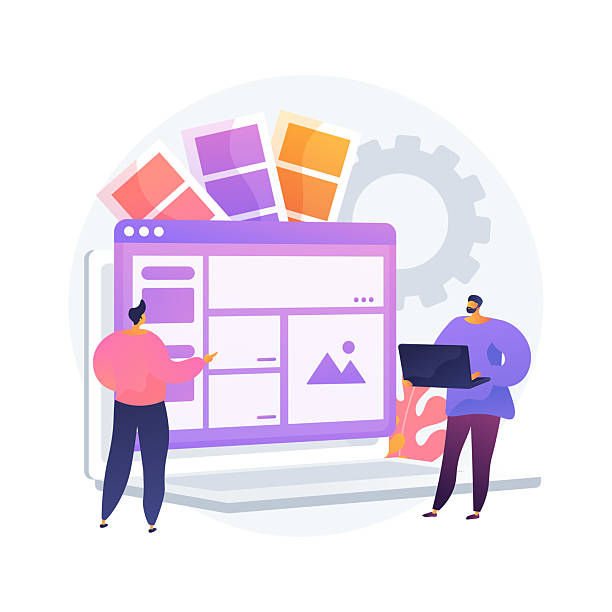
The world of e-commerce is rapidly evolving, and e-commerce website design is undergoing massive transformations in sync with these changes.
Anticipating future trends and preparing for them is crucial for any business that intends to remain and grow in this competitive market.
This section examines some of the most important new trends in online store design and development.
This analytical and informative content provides thought-provoking material for you.
#Emerging_trends and #digital_commerce are shaping the future.
One of the most prominent future trends is Social Commerce.
With the increasing penetration of social networks in daily life, the ability to buy directly from platforms like Instagram, Facebook, and TikTok is rapidly growing.
E-commerce website design in the future must be such that it seamlessly integrates with these platforms and provides a smooth and uninterrupted shopping experience in the social environment.
This means direct selling within social apps and utilizing their interactive features to attract customers.
Artificial Intelligence (AI) and Machine Learning will also play an increasing role in website design.
From AI-powered chatbots for customer support and answering frequently asked questions to Recommendation Engines that suggest related products based on users’ past behavior, AI can personalize the user experience and significantly increase conversion rates.
Personalization is key to future success.
Voice Commerce and Augmented Reality (AR) are also taking shape.
With the expansion of voice assistants like Alexa and Google Assistant, purchasing through voice commands is becoming a reality.
E-commerce website design in the future may require optimization for voice searches.
On the other hand, AR allows customers to virtually view products in their real environment before purchasing (e.g., virtually trying on clothes or seeing furniture in their living room), which helps reduce return rates and increase buyer confidence.
Sustainability and corporate social responsibility have also become important factors in brand selection.
Customers are looking for brands that care about environmental and social issues.
E-commerce website design in the future should clearly reflect these values, including transparent information about product sourcing, sustainable production processes, and corporate charity programs.
These new trends indicate that the future of e-commerce will be increasingly based on personalized, interactive, and responsible experiences.
Frequently Asked Questions and Key Tips for Starting E-commerce Website Design

For many businesses, the idea of launching an online store and investing in e-commerce website design comes with many questions and ambiguities.
This section answers some frequently asked questions and provides key tips for starting this important journey, so you can take steps with more confidence.
This guidance and educational content is essential for you to get started.
#FAQs and #Getting_Started clarify your path.
One of the first questions is, “How long does it take to design an e-commerce website?” The answer to this question depends on the complexity of the site, the platform choice (ready-made or custom), and the number of products.
A simple site with ready-made platforms like Shopify might launch in a few weeks, while a custom platform with complex functionalities could take several months.
Detailed planning and setting realistic goals at the beginning of the project are very important.
Another common question is, “How much does e-commerce website design cost?” This cost also varies and depends on several factors: the type of platform (SaaS platforms like Shopify have monthly fees, while open-source platforms like WooCommerce have initial hosting and development costs), the need for specific customizations, graphic design, integration with other systems, and SEO and marketing services.
It is important to set a realistic budget and prioritize investment in quality.
“Do I need a lot of technical knowledge to manage an online store?” This also depends on the platform.
User-friendly platforms like Shopify are more suitable for individuals without high technical knowledge, while platforms like Magento require more technical expertise.
However, even on the simplest platforms, basic computer and internet literacy and a willingness to learn are required.
Many e-commerce website design companies also offer support and training services.
Another key point is #market_research and #understanding_the_target_audience.
Before starting any e-commerce website design, you need to know who you are targeting, what their needs are, and how you can provide the best shopping experience for them.
This information helps you correctly tailor your design, content, and marketing strategies.
Finally, your e-commerce website should not be a static project; rather, it should be a living entity that is constantly updating, improving, and evolving. Collecting customer feedback, monitoring analytical data, and staying aware of new industry trends all help you keep your online store at its peak and achieve sustainable success.
By observing these tips, you can enter the competitive world of e-commerce with greater confidence.
Frequently Asked Questions
| Question | Answer |
|---|---|
| What is e-commerce website design? | The process of creating an online platform for selling products or services, which includes designing the User Interface (UI), User Experience (UX), and necessary functionalities for online shopping. |
| What are the key features of a good e-commerce website? | Easy navigation, high loading speed, powerful search capability, efficient shopping cart, secure payment gateway, clear product display with high-quality images, ability to display user reviews, and responsiveness (mobile compatibility). |
| Which platforms are common for e-commerce website design? | Popular platforms like WooCommerce (on WordPress), Shopify, Magento, PrestaShop, and also custom Content Management Systems. |
| What is the importance of an e-commerce website being responsive? | Given the increasing use of mobile devices for online shopping, a responsive website (correct display on different screen sizes) is crucial for providing a good user experience and increasing conversion rates. |
| How long does the process of designing an e-commerce website usually take? | The duration depends on the complexity of the project, the number of products, specific required functionalities, and the implementation method, and can vary from a few weeks to several months. |
And other services of Rasa Web Advertising Agency in the field of advertising
How to use the experiences of other manufacturers to improve advertising
Examining the importance of direct contact in online advertising
How to use daily market changes to improve advertising
The role of positive customer reviews in increasing the credibility of online advertising
How to benefit from offering special services in online advertising
And more than hundreds of other services in the field of internet advertising, advertising consultation, and organizational solutions
Internet Advertising | Advertising Strategy | Advertorial
🚀 Transform your business’s digital presence with Rasa Web’s internet advertising strategies and advertorials.
📍 Tehran, Mirdamad Street, next to Bank Markazi, Kazerun Jonubi Alley, Ramin Alley, No. 6
